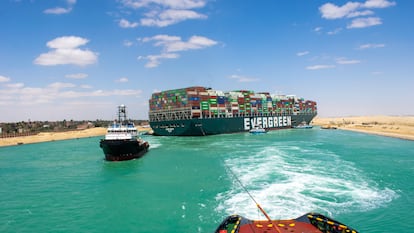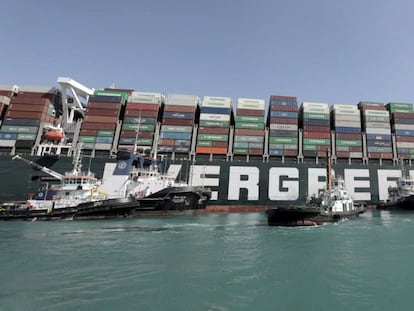The long hangover of the ‘Ever Given’ global trade disruption
Disputes persist two years after one of the world’s largest container ships blocked the Suez Canal for six days

They call them “big boys” for a good reason. If you’ve never seen one up close, it’s hard to understand the dimensions of these ships, often compared to floating skyscrapers. The Ever Given is 1,300 feet (400 meters) long and 193 feet (59 meters) wide. New York’s Empire State Building is shorter at 1,250 feet (382 meters). Two years ago, photos of the Ever Given grounded for six days in the Suez Canal made all the TV news reports and front pages. The incident dispelled any notions about the infallibility of globalization after a single blockage of a major commercial artery was enough to cause worldwide supply problems. “It was like a beached whale,” said Peter Berdowski, CEO of Boskalis, the company that owns SMIT, the Dutch salvage company that played a crucial role in the effort to refloat the mega-ship.
Two years after its all-out effort to free the ship from the Egyptian mud, Boskalis is still in litigation in the London courts against Shoei Kisen Kaisha, the Japanese company that owns the Ever Given. Boskalis claims it’s owed more money and is not the only one. Danish shipping giant Maersk claims it’s owed $43 million (€40 million) for losses incurred while its container ships were stuck for days waiting to pass through the Suez Canal. At one point, 372 ships were anchored on both ends of a canal that handles more than 10% of global maritime trade.
Between 80-90% of the world’s goods are transported by sea. It’s probably one of the most unknown and underappreciated cogs in the global economy because it works in distant oceans, far from the thoughts and lives of ordinary people. But globalization would be very different without it. Maritime transport is far cheaper than air transport, so it helps maintain low prices for consumers. When the Ever Given blocked the massive flow of goods to and from Europe, the Middle East and Asia through the Suez Canal, everyone knew about it. The numbers were staggering – some said losses amounted to $400 million per hour, $10 billion daily.
With so much money at stake, the salvagers were under enormous pressure. SMIT says it performs about 50 salvage operations annually, but most go unnoticed because they are conducted in remote areas with lower economic and environmental impacts. Other salvage operations, like the 2012 Costa Concordia cruise ship, are more notorious because of the toll on human lives – 32 people died after the vessel capsized due to negligence. The captain, Francesco Schettino, was sentenced to 16 years in prison.
The Ever Given was en route from Malaysia to Rotterdam when strong winds of over 40 knots caused sandstorms that blew the ship off course at 7:40 am on March 23. Although most vessels can traverse the Suez Canal easily, it can be tricky for others in poor weather conditions. The canal is 985 feet (300 meters) wide, but only the middle is deep enough for a ship like the Ever Given with a hull that draws 52.5 feet (16 meters) of water.
The 23 Indian crew members were not injured when the ship ran aground, so all efforts focused on minimizing the economic impacts. Hundreds of millions of people were affected by every passing hour: consumers waiting for furniture, car manufacturers waiting for chips, supermarkets waiting for food, and everyone waiting for oil. No one knew how long it would take. At first, the Suez Canal Authority thought it would be a matter of hours, but SMIT said it could take weeks. In light of the uncertainty, shipping companies were forced to make a difficult choice: leave their ships there and risk a prolonged wait, or take the long way around South Africa’s Cape of Good Hope. “It’s easy to take a detour if a truck has an accident, but here the alternative route was 4,300 miles (7,000 kilometers) longer,” says The Salvage of the Ever Given, a book published by Boskalis that tells the inside story of the incident.
Hapag-Lloyd, the fifth largest shipping company in the world, told EL PAÍS how they dealt with the crisis. “We had less than a dozen ships stuck outside the Suez Canal, so we diverted some of them around the Cape of Good Hope. Like everyone else in the industry, we experienced delays in the Far East, India-Europe/US, and Middle East-Mediterranean trade routes. We also dealt with port congestion when all the delayed ships reached their ports simultaneously.”
The salvage company’s 80-page account reveals the intensity of the effort and its pride in freeing the Ever Given. The engrossing inside story describes multiple complementary plans: use heavy tugboats and support vessels to pull it out; dredge the area around the ship to free the bow from the sand; and unload 600 of the ship’s 18,350 containers with a crane and pump out ballast water to lighten the load. Other alternatives, such as emptying the fuel tank, were rejected because of a lack of storage space for the fuel.
Compensation
At 3:05 pm on March 29, 2021, the Ever Given started to budge. Rising tides, tugboats pulling at full throttle, and suction dredges pumping sand away from the ship finally freed the giant container ship. Traffic began to move again through the Suez, although the Ever Given stayed put for another 100 days while the Japanese shipowner negotiated compensation with the Suez Canal Authority. The figure started at $755 million but has now dropped to $465 million. Many parties were affected, from the canal owner who lost income from rerouted fee-paying vessels to the delayed ships, some of whom spent much more on fuel to travel longer routes. The Dutch salvage company worked closely with the Suez Canal Authority under a contract with pre-established rates. However, the variable compensation in the contract is now being disputed in the London courts. Industry sources note that similar disputes are often resolved in arbitration or legal proceedings.
Emilio de la Cruz, Maerk’s managing director for Western Europe and the Maghreb region, says that the pandemic and the Ever Given incident have driven changes in global trade. “Resilience and flexibility are being built into supply chains as reinforcement, even if that comes at a cost. It’s a ‘just in case’ approach rather than ‘just in time and as cheaply as possible.’ The trend is to reduce the number of logistics providers to achieve better and quicker responses to disruptions,” he said. The Suez Canal Authority has not been idle either. To avoid another Ever Given nightmare, it has been working for over 18 months on deepening the southern section of the waterway and lengthening the parallel canal built in 2014.
Sign up for our weekly newsletter to get more English-language news coverage from EL PAÍS USA Edition
Tu suscripción se está usando en otro dispositivo
¿Quieres añadir otro usuario a tu suscripción?
Si continúas leyendo en este dispositivo, no se podrá leer en el otro.
FlechaTu suscripción se está usando en otro dispositivo y solo puedes acceder a EL PAÍS desde un dispositivo a la vez.
Si quieres compartir tu cuenta, cambia tu suscripción a la modalidad Premium, así podrás añadir otro usuario. Cada uno accederá con su propia cuenta de email, lo que os permitirá personalizar vuestra experiencia en EL PAÍS.
¿Tienes una suscripción de empresa? Accede aquí para contratar más cuentas.
En el caso de no saber quién está usando tu cuenta, te recomendamos cambiar tu contraseña aquí.
Si decides continuar compartiendo tu cuenta, este mensaje se mostrará en tu dispositivo y en el de la otra persona que está usando tu cuenta de forma indefinida, afectando a tu experiencia de lectura. Puedes consultar aquí los términos y condiciones de la suscripción digital.
More information
Últimas noticias
Most viewed
- Sinaloa Cartel war is taking its toll on Los Chapitos
- Oona Chaplin: ‘I told James Cameron that I was living in a treehouse and starting a permaculture project with a friend’
- Reinhard Genzel, Nobel laureate in physics: ‘One-minute videos will never give you the truth’
- Why the price of coffee has skyrocketed: from Brazilian plantations to specialty coffee houses
- Silver prices are going crazy: This is what’s fueling the rally











































